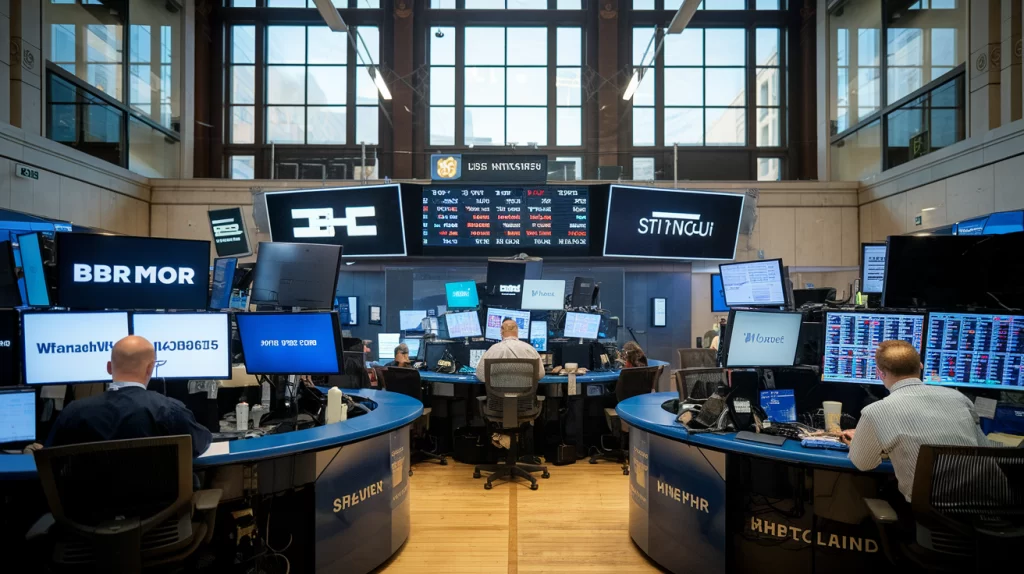How to Financially Prepare for Breaking Points in the Stock Market
Stock Market: Investing in the stock market can be challenging, especially when the economy is shaky and stock prices jump. Knowing what affects stock prices and how to handle risks is key. You can become stronger by preparing your finances for market ups and downs.
The Indian stock market is always moving, with companies sharing their results every three months. These results can really change stock prices, like with Happiest Minds and Route Mobile’s IPOs. But, things like foreign investors selling stocks can also make the market unstable.

To prepare for market ups and downs, create a strong investment mix that can handle short-term drops while growing over time. This means spreading your money across different areas based on how much risk you can take and focusing on the long haul. This way, one bad event won’t hit your whole portfolio hard.
Having an emergency fund for sudden costs or losses when the market drops is also key. This fund should be enough for 3-6 months of bills and easy to get to when needed. Also, putting money into safe assets like government bonds, gold, or defensive stocks can help during tough times.
Having a detailed financial plan that includes market ups and downs is vital. This plan should outline your investment goals, how much risk you can handle, and how to deal with market changes. By monitoring your plan and adjusting it as needed, you can keep moving towards your financial goals.
Also Read: Why Are Taxes So Complicated? Ultimate Positive One
Key Takeaways
- Understand the factors influencing stock prices in the Indian market, including quarterly results and external events
- Build a diversified investment portfolio to manage risk and deliver long-term growth
- Create an emergency fund to cover unexpected expenses during market downturns
- Invest in recession-proof assets for stability during uncertain times
- Develop a comprehensive financial plan that accounts for market volatility and regularly review and adjust it
Understanding the Indian Stock Market
Knowing the setup of the Indian stock market and what affects stock prices is key to getting good at it. It has two main parts: the primary and secondary markets.
Types of Stock Markets in India
Companies start by issuing stocks in the primary market through IPOs or FPOs to get money. These stocks were then traded on places like the Bombay Stock Exchange (BSE) and the National Stock Exchange (NSE).
The BSE started in 1875, is India’s oldest stock exchange and is very important for finance. It has the top companies and the Sensex index, which shows India’s economy. The NSE, which started in 1993, is now the fourth-biggest stock exchange in the world by trading volume. It has the NIFTY 50 index, which has 50 big company stocks.
The Indian stock market includes more than just the BSE and NSE. It also includes bonds, mutual funds, and ETFs. OTC markets are for trading bonds and penny stocks directly between people.
Also Read: Capital Gains Budget Impact: Ultimate Guide to Tax on Property
Factors Impacting Stock Prices
Knowing what affects stock prices is key to making money from them. These factors can be inside or outside the company. Inside, they include growth, plans to buy other companies, and news about buying back shares or giving out bonuses. Outside, they include the economy, inflation, and interest rates.
High inflation means prices increase and people spend less, hurting companies’ sales and profits. To pick good stocks, look at a company’s finances and business and how it compares to others or the market.
| Factor | Impact on Stock Prices |
|---|---|
| Company Growth Expectations | Positive growth prospects can lead to higher stock prices |
| Acquisition Plans | Acquisitions can boost market sentiment and drive stock prices up |
| Buyback Offers | Buybacks can increase demand for shares, leading to price appreciation |
| Bonus Announcements | Bonus issues can attract more investors, pushing stock prices higher |
| GDP Growth | Higher GDP growth can positively impact stock prices |
| Inflation | High inflation can hurt consumer spending and negatively affect stock prices |
| Interest Rates | Lower interest rates can boost stock prices, while higher rates may have a negative impact |
Knowing about the Indian stock market and what affects stock prices helps you make better investment choices. Equity investments have done well over time, averaging about 10% a year.
Building a Resilient Investment Portfolio
Having a strong investment portfolio is key when the market is up and down. Smart diversification andasset allocationhelp you better handle market changes. Let’s look at how to make a portfolio that can handle ups and downs and keep growing over time.
Diversification Strategies
Diversification means spreading your money across different types of investments. This way, you can grow your money in various areas and protect it from bad economic times. A mix of sectors and market sizes can lead to steady returns on your money.
Investing in stocks, bonds, real estate, commodities, and cash can balance your portfolio. Stocks can grow a lot, but bonds give you a steady income. Real estate can protect you from inflation, and commodities guard against rising costs.
Asset Allocation for Risk Management
Asset allocation means picking the right mix of investments based on your risk level, goals, and how long you plan to invest. This approach helps manage risk and aim for better returns. A good portfolio looks at momentum, value, and volatility to lower risks and avoid big losses.
Think about how much risk you can take and set your asset mix. If you’re cautious, put more in bonds and cash. If you’re bold, go for more stocks. It’s important to rebalance your portfolio regularly to align with your goals and market changes.
Importance of Long-term Investing
Investing in stocks for the long haul is key. Markets go up and down, and companies have good and bad times. Trusting in the long-term success of many businesses is vital. Letting your investments grow over time is key to seeing long-term gains.
Those who stay calm during market lows often do better in the end. Instead of selling in panic, being patient and disciplined can lead to better outcomes. Focus on quality companies with strong foundations to benefit from the stock market’s long-term growth.
Building a resilient portfolio through simplicity can help investors make informed decisions even in turbulent times.
In summary, making a strong investment portfolio means using smart diversification, wise asset allocation, and a long-term view. Spread your investments across different areas to reduce risk and find growth chances. Investing is a journey. Stay disciplined and focused on your goals to navigate market ups and downs and succeed.
How to financially prepare for breaking points in the stock market in India
Handling the ups and downs of the Indian stock market can be challenging, especially when things get volatile. To prepare for market ups and downs, being proactive is key. This means building an emergency fund, investing in assets that keep their value, and having a solid financial plan.

Creating an Emergency Fund
Setting up an emergency fund is vital in preparing for market changes. This fund should cover your basic costs for 3-6 months. This gives you a safety net during tough times. You can build a substantial emergency fund by regularly saving a bit of your income. This fund can help you through market lows without touching your long-term investments.
Investing in Recession-proof Assets
To stabilize your finances, think about putting some money into recession-proof assets. These assets usually keep their value or even grow when the economy is down. Some good examples are:
- Gold: Gold is often seen as a safe investment during market ups and downs.
- Government bonds offer a steady income and are generally safer than stocks.
- Defensive sectors: Sectors like healthcare, consumer staples, and utilities are less affected by economic changes. They can be good choices during market lows.
Adding recession-proof assets to your investments can help reduce the risk from market swings.
Developing a Financial Plan for Market Volatility
Creating a solid financial plan is key to handling the stock market’s ups and downs. This plan should have several important parts:
- Setting realistic expectations: Understand that market changes are normal and adjust your goals accordingly.
- Defining investment goals: Clearly state your financial aims, considering your risk level and time frame.
- Regular portfolio review and rebalancing: Check your investments often and adjust them to match your goals and risk tolerance.
Put some money into stocks for big goals like retirement or saving for a child’s education. Since you won’t need this money immediately, it can ride out market ups and downs and earn more over time.
Smart investing based on market trends and analysis is key to doing well in the stock market.
| Investment Strategy | Objective | Risk Level |
|---|---|---|
| Emergency Fund | Stay stable during market lows | Low |
| Recession-proof Assets | Make your investments more stable and reduce risk | Low to Medium |
| Long-term Equity Investments | Grow your wealth and increase potential earnings | High |
By using these strategies and sticking to your financial plan, you can better handle the challenges of the Indian stock market. Remember, good money management and stop-loss orders are key to limit losses. With a solid financial plan and a long-term view, you can confidently face market ups and downs and work towards your financial goals.
Conclusion

Preparing financially for the ups and downs in the Indian stock market is key to long-term success. Diversifying your portfolio across different types of investments helps lessen the effects of market ups and downs. By picking where to put your money based on how much risk you can handle and your goals, you can make a portfolio that stands strong through tough times.
Having an emergency fund of 3-6 months of expenses is a big part of being financially ready. This fund helps you avoid selling stocks when the market drops, which usually doesn’t last long. Also, putting money into things like government bonds, gold, and stocks that do well even when the market is down can help keep you stable.
Creating a detailed financial plan that considers market ups and downs is key to long-term success. This plan should include balancing your portfolio and setting realistic return goals based on past market trends. The India National Stock Exchange has seen over 19 big drops in the last 30 years, with some drops as big as 10% to 20%.
“The case for equity investing is strong and persuasive for long-term goals, as it offers the potential for capital appreciation and growth. However, it is crucial to approach equity investing as a portfolio rather than betting on individual stocks.”
Investing in stocks successfully means spreading your investments out, giving them time to grow, and focusing on companies’ real value. By looking at the big picture and checking in on your investments often, you can handle the stock market’s ups and downs with more confidence and financial strength.
Strategy of Stock Market
| Strategy | Description |
|---|---|
| Diversification | Spread investments across various asset classes, sectors, and geographies to minimize risk |
| Asset Allocation | Allocate assets based on risk tolerance and investment goals for a balanced portfolio |
| Emergency Fund | Maintain 3-6 months of living expenses to avoid selling investments during market corrections |
| Recession-proof Assets | Invest in government bonds, gold, and defensive stocks for stability during turbulent times |
| Financial Planning | Develop a comprehensive plan that accounts for market volatility and includes regular portfolio rebalancing |
By using these strategies and adhering to a disciplined investing plan, you can weather the tough times in the Indian stock market. Remember, being financially ready and managing your investments well are key to building a strong stock market presence and securing a bright financial future.
FAQs
What are circuit breakers in the Indian stock market?
Circuit breakers stop trading when stock prices go up or down significantly. In India, they kick in when the index changes by 10%, 15%, or 20%. The break time depends on when this happens.
How can investors strategically use circuit limits in the Indian stock market?
Investors can use circuit limits to make smart plans. They can pick stocks with higher limits for more potential gains. But, remember, circuit limits don’t promise profits because other market factors can affect them. Mixing stocks, bonds, and other assets in your portfolio can help reduce risk. Government securities (G-Secs) are very safe, with no risk of default and tax breaks on interest.
What are some key risks associated with investing in debt securities in India?
Investing in debt securities comes with risks. Default risk means the issuer might not pay back interest or principal on time. Interest rate risk happens when market rates go down, lowering the yield on your investments. Reinvestment rate risk is when you can’t reinvest interest at the higher rates you expected. Counterparty risk is when the other party doesn’t deliver the agreed security or value. And price risk means you might not get the expected price because of market changes.
FAQ
Is investing directly in the stock market suitable for everyone?
Not everyone can invest directly in the stock market. It’s a risky way to make money with no promise of returns, but it has yielded higher returns over time than other investments.
How can investors earn money from the stock market?
Investors make money when stock prices go up. They also earn from the dividends companies pay out.
What factors impact stock prices in the Indian market?
Many factors affect stock prices in India. These include company performance, growth plans, and major economic factors like GDP and inflation.
How is the Indian stock market divided?
The Indian stock market has two main parts: primary and secondary markets. Companies list their shares in the primary market through IPOs or FPOs. Then, people trade these shares in the secondary market.
What is the impact of high inflation on the stock market?
High inflation means prices increase, and people have less money to spend. This can hurt companies’ sales and profits.
Why is building a diversified portfolio crucial for managing risk?
Spreading your investments across different sectors and sizes is key to managing risk. Focusing on just one area can be risky, and diversifying helps protect against bad times in one sector.
What is the benefit of giving investments enough time in equity investing?
Time is key in equity investing. Markets go up and down, and companies have good and bad times. It is important to trust in the long-term success of many businesses.
How can creating an emergency fund help prepare for breaking points in the stock market?
An emergency fund helps you be ready for tough times in the stock market. It should have enough money for 3-6 months of living expenses.
What are some recession-proof assets to invest in during market downturns?
During downturns, consider investing in assets like gold, government bonds, and sectors like healthcare and consumer staples. These can help keep your investments stable.
How can a financial plan help in preparing for stock market volatility?
A financial plan is vital for dealing with market ups and downs. It sets clear goals, defines your investment strategy, and helps you keep your portfolio in balance.
Laarn more: What Is the Stock Market and How Does It Work?
Thank you for reading this post, don't forget to subscribe!






